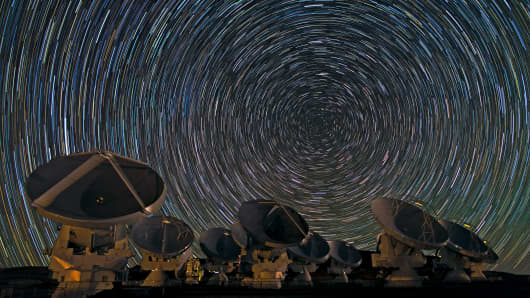In the high desert of the Chilean Andes, 16,500 feet above sea level, a $1.5 billion international telescope was brought to full power on Wednesday, enabling mankind to peer deeper into space and further back in time than ever before.
The Atacama Large Millimeter Array, or ALMA, is a group of 66 interconnected radio telescopes and is heralded as the world's largest ground-based array and humanity's most powerful telescope. Operating through a supercomputer in extreme synchronicity, ALMA will be exponentially more powerful than any of its predecessors and about 10 times more powerful than NASA's Hubble telescope.
The project is jointly funded by the United States, Canada, the European Union, Japan and Taiwan and done in collaboration with Chile.
The project, estimated to cost $1.3 billion to $1.5 billion, has been under way for a decade, with construction starting in 2005. Before becoming fully operational, ALMA has already made a range of discoveries, including a molecular building block of life around a young star and new observations of dust clouds near failed stars. Wednesday marked ALMA's official inauguration to become a fully operational observation center.
(Read More: The Richest Places in the Universe - A Diamond Planet, Seas of Natural Gas)
When its full potential is reached, the telescope will be able to observe cosmic phenomena dating to the early universe—to just several million years after the Big Bang— allowing scientists to directly observe events from further in the past than ever before. The Big Bang, the leading theory about the origin of our universe, is estimated to have occurred approximately 13.77 billion years ago.
"To me, it's just spectacular that we can look 12 billion years in time with an instrument like ALMA," Jim Ulvestad, director of the Astronomical Sciences Division at the National Science Foundation's Directorate for Mathematical and Physical Sciences, said at a news conference attended by Space.com.
Light detectable by ALMA is so faint—so distant and moving so quickly away from us—that it has stretched into the infrared part of the spectrum, outside the range of visible light, an extreme example of the phenomenon known as a Doppler Shift.
To study this type of information, scientists must make use of radio telescopes instead of more traditional optical telescopes that use mirrors, because they are dealing with radiation of longer wavelengths—between a few hundred micrometers to about 1 millimeter—which are outside the "visible" part of the light spectrum.
Generally, the larger the satellite dish, the better the resolution and the deeper into space scientists can see. Instead, ALMA uses an array of smaller antennas, measuring 7 meters to 12 meters in diameter, making use of a technique called interferometry. With the technique, smaller dishes working in synchronicity combine signals to produce a resolution equivalent to an individual dish comparable in size to the distance between individual components. ALMA's diameter is approximately 9.9 miles (16 kilometers).
"ALMA is a telescope that is basically 100 times more powerful than any similar millimeter telescope that's ever been built before," Ulvestad said at the news conference.
In addition to its ability to see into far-off areas of space, ALMA will be able to image the movement and interaction of gas in young stars and planets in formation, according to the array's website. This ability will allow scientists to observe the formation of young planets around young stars and glean insight into the formation of our own solar system.


